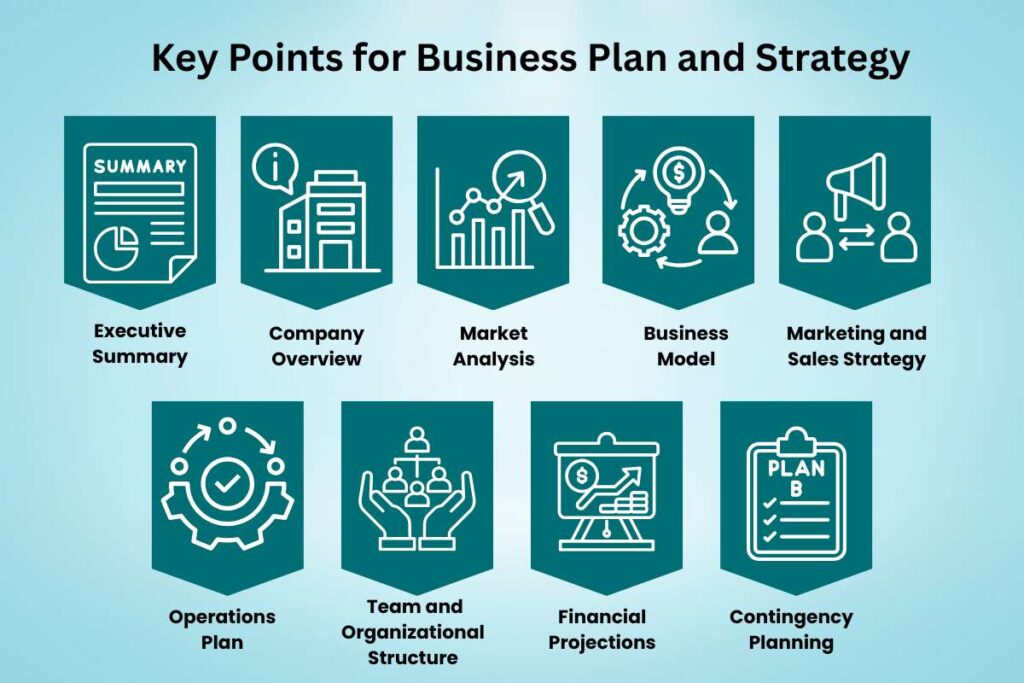Every successful business begins with a solid foundation, whether a startup in a garage or a global brand in a skyscraper. That foundation is a well-thought-out plan and strategy. These aren’t just buzzwords tossed around in boardrooms; they’re the backbone of clarity, focus, and sustainable growth.
Without them, a business is just sailing without a compass. With them, it becomes a ship with a destination, a route, and the tools to weather any storm. So, what makes a good business plan and strategy? How do you align vision with execution? And more importantly, why does it all matter?
Why a Business Plan and Strategy Matter More Than Ever?
A great product or service is not enough in today’s competitive world. Businesses need direction — a clear path with defined goals, an understanding of the market, and a strategic approach to stand out.
A business plan and strategy act as a roadmap. They help entrepreneurs identify what they’re offering, who they’re offering it to, and how they’ll do it better. They bring clarity during uncertainty and are a benchmark when reviewing performance or pivoting when things change.
It’s not just about writing a document to impress investors. It’s about bringing your vision to life and creating a working blueprint you and your team can follow.
➤ 9 Key Points for Business Plan and Strategy
Whether you’re building a café, launching a fintech app, or growing a sustainable clothing brand, the structure of your business should revolve around these core elements:

1. Executive Summary
This is the opening act. It should provide a snapshot of what the business is, what it plans to do, and how it plans to succeed. This section must be concise but compelling.
2. Company Overview
Outline the mission, vision, legal structure, ownership, and brief history (if any). This helps build trust and background for whoever reads it.
3. Market Analysis
Understanding your market is non-negotiable. Who are your customers? What are their problems? Who are your competitors? What’s trending? This section proves you’ve done your homework.
4. Business Model
How do you make money? Whether through direct sales, subscriptions, affiliate partnerships, or freemium models, the business model must be transparent and scalable.
5. Marketing and Sales Strategy

Here’s where the strategy shines. How do you plan to attract customers? What channels will you use — social media, email, paid ads, in-person networking? What’s your customer acquisition cost? How do you retain them?
6. Operations Plan
This section outlines how your business will run efficiently, from day-to-day processes to supplier chains and logistics.
7. Team and Organizational Structure
Who are the people behind the scenes? Investors and stakeholders want to know the talent you’ve assembled and their roles.
8. Financial Projections
Provide revenue forecasts, break-even analysis, profit and loss statements, and cash flow projections. This is the part where dreams meet numbers.
9. Contingency Planning
A great business plan and strategy anticipate risk. What’s your plan if things don’t go as expected? Having a backup shows maturity and preparedness.
➤ Bringing Strategy into the Real World
Let’s take an example. Imagine you’re launching an online tea brand that sells organic blends sourced from small farmers. You’re passionate, have good suppliers, and an appealing product line. But how will you reach your target audience? What’s your brand voice? Will you focus on health benefits or taste? Who are your competitors, and what are they doing better?
Your business plan and strategy will answer all of these. For instance, your strategy may involve influencer partnerships for awareness, content marketing to educate users, and email campaigns to convert. Meanwhile, your plan will document your operations, team, financial goals, and rollout timelines.
A real-world strategy means combining data with intuition. Writing a plan is not enough; you must live it, adapt it, and evolve it as your business grows.
Similar Article: 10 Most Profitable Businesses to Start Today and Build Wealth
➤ Common Pitfalls to Avoid
Even seasoned entrepreneurs sometimes miss the mark. Remember, your plan and strategy are a living document. Update it as you learn, grow, and scale.

When writing your business plan and strategy, avoid these common traps:
- Too vague or too detailed: You want enough detail to be useful but not so much that it becomes unreadable.
- Ignoring the market: Many businesses fail because they don’t truly understand who they’re serving.
- Overestimating sales: Optimism is excellent, but realism gets funded.
- No straightforward marketing approach: A plan without a go-to-market strategy is a non-starter.
- Skipping the update process: Your business and your plan are evolving.
➤ From Planning to Execution
You can have the best-written plan in the world, but execution is where the rubber meets the road. Success is not just about writing it down, but about doing the work every day. Your business plan and strategy are only as good as your ability to act on them.
This means checking your progress regularly, adjusting your strategy in response to market changes, and being candid about what’s working and what’s not.
Create timelines. Assign responsibilities. Hold yourself and your team accountable. Every milestone you hit brings your vision one step closer to reality.
➤ Digital Tools That Can Help
Technology makes writing and implementing a business plan easier than ever. Even with tools, the heart of your business plan and strategy comes from your thinking, your team’s input, and your understanding of the customer.

Here are a few tools that can elevate your strategy:
- LivePlan – for structured business plan templates
- Trello/Asana – for task management and team alignment
- Canva – to build professional-looking decks or visuals
- Google Sheets – to track budgets and forecasts
- HubSpot – for marketing automation and CRM
Conclusion
A great business plan and strategy are not a luxury; they’re a necessity. It helps turn ideas into action and visions into ventures. It keeps you grounded, guides your decisions, and gives investors and employees something to rally behind.
Business is rarely predictable, but a thoughtful plan makes it navigable. Whether you’re just starting or scaling up, take the time to build your strategy right. Because when the foundation is solid, your business can go anywhere.


















